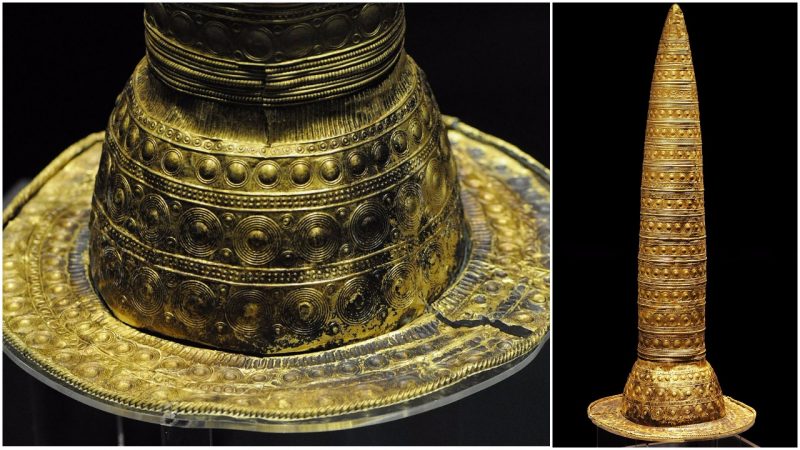When we think of wizards, it’s all about magic wands, long (usually black) robes, and a pointed hat. Just mentioning the word hat, many of us recall the Sorting Hat of Harry Potter, probably the most extraordinary magical hat in any fictitious world.
Looking ancient and battered, the Sorting Hat appears to have a mind of its own, able to penetrate the thoughts of any new student coming to Hogwarts and direct them to the proper house of the magical school where they belong.
Besides Harry Potter characters, there is a plethora of other figures of fiction whom we simply cannot imagine without their hats, be it Gandalf from The Lord of the Rings or Merlin from the Arthurian legends.
But are magic hats reserved for fictitious characters? History tells the story of the Berlin Gold Hat, and then there’s the Golden Hat of Shifferstadt. As it turns out, these artifacts, primarily made of thin gold, were likely worn as ceremonial hats by ancient wizards, known as “oracles,” all the way back to the Bronze Age.
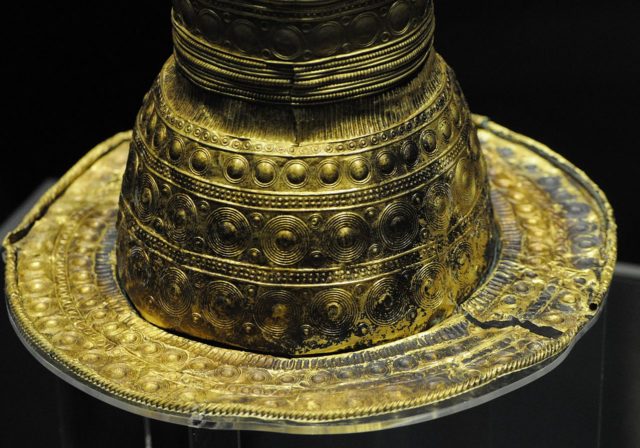
So far four golden cone-shaped hats have been discovered in Germany, Switzerland, and France. All of them appear to be adorned with symbols of astrology, and the ancients who used them had the knowledge to foretell the movements of the two most important stellar objects to us, the sun and the moon.
For ages, these artifacts with their strange astrological decoration were a mystery among scholars. In the past, many have claimed that the golden cones were intended as ceremonial jars and ornaments only. It was broadly believed that they fulfilled the function of decorative covers, which the ancients probably laid atop wooden posts that were placed around worship sites in the Bronze Age. This claim was largely accepted among scholars.
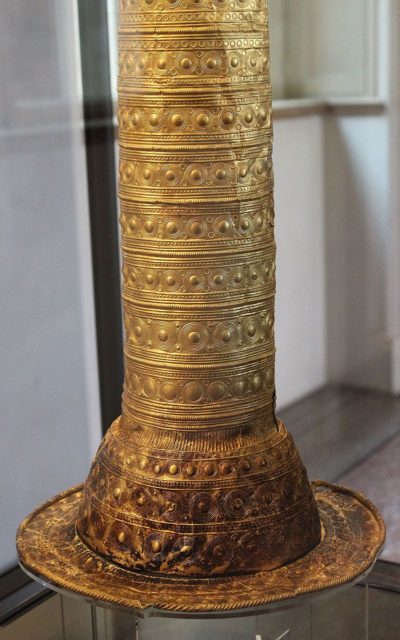
But serious research conducted by German researchers from the Berlin Museum for Pre and Early History has provided a more plausible answer to the mystery. They assert that initially it was high-ranking figures such as “king-priests” who wore these cone hats during ceremonies in Bronze Age Europe. Communities would have held great belief in the ability of the king-priest to precisely determine the best time to plant or harvest the the fields. According to Wilfried Menghin of the Berlin Museum, one of the researchers in the case of these three-millennia-old Bronze Age cones, “They would have been regarded as Lords of Time who had access to a divine knowledge that enabled them to look into the future.”
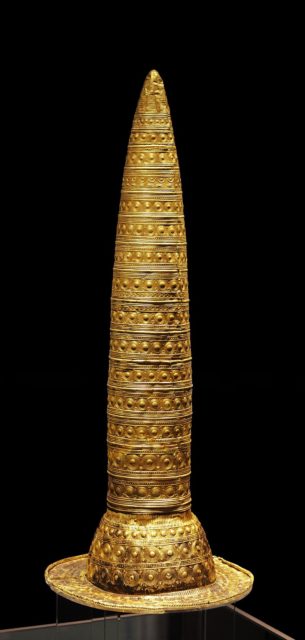
One of the best-preserved cones makes for a significant possession of the Berlin Museum. Thirty inches tall, the golden artifact was bought by the museum in 1996 after being unearthed in Switzerland.
The surface of the Berlin cone is adorned with an astonishing number of sun symbols and half-moon figures, 1,739 to be exact. And it has been determined that all these little figures create a sophisticated code that accurately matches the Metonic cycle, a finding attributed to Meton, a Greek astronomer of the 5th century BC (five centuries after this cone was produced).
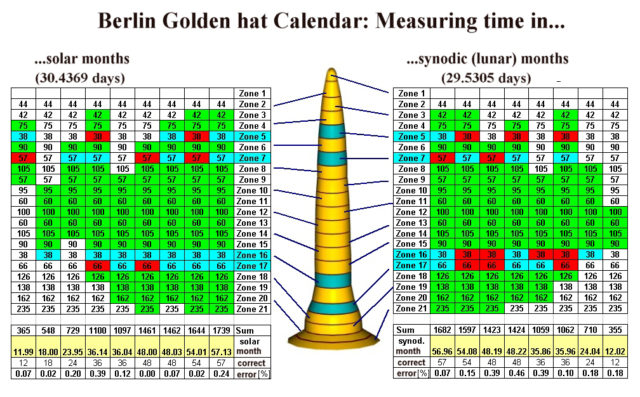
As Menghin explains, all of the symbols on the hat offer a logarithmic table that would have allowed its users to make some rather advanced calculations of the motions of the sun and the moon. Bearing that in mind, the people of the Bronze Age likely had the knowledge of how to conduct progressive astrological observations of the celestial bodies.
The Berlin Hat appears to be the most recent of the four. A second hat, which is called the Golden Hat of Schifferstadt, found in a well preserved state near the city of Speyer in Germany, appears to be the earliest sample of this type of artifact. It was also discovered much earlier, in 1835, and is thought to be at least 300 years older than the Berlin Hat.
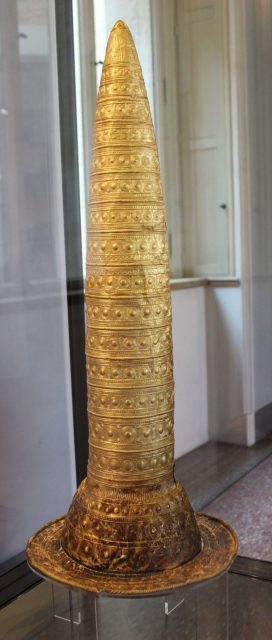
A third hat named the Avanton Gold Cone was unearthed in France in 1844, and the fourth one called the Golden Cone of Eseldorf-Buch was found, again in Germany. Compared with the first two golden cones, these two appear to have parts missing. In the case of the Eseldorf-Buch cone, its top is quite damaged, either by digging tools from when it was excavated or even earlier when it was used in ancient ceremonies.
Other scholars argue that such “king-priest” figures were present in other cultures and areas of prehistoric Europe. The Gold Cape of Mold, also made of beaten gold and dated to the Bronze Age, may just be one more item that complemented the ceremonial dress of the early oracles in Wales, where it was found. A possession of the British Museum, this piece also appears to have an original shape and design.
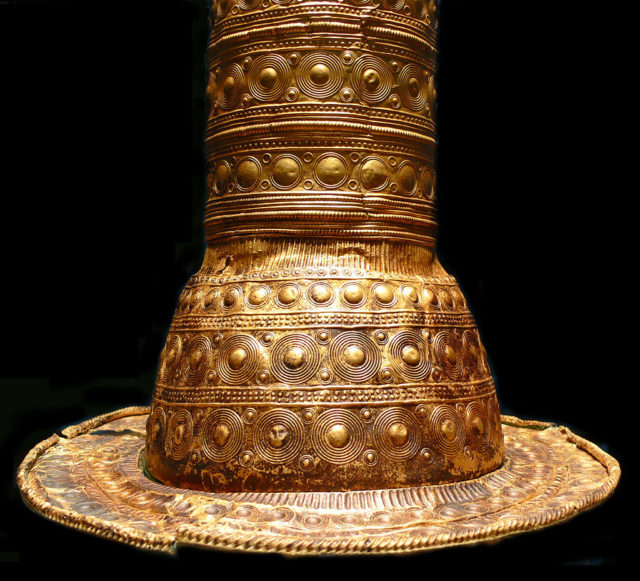
Reportedly, five more golden cones similar to those kept at present in Germany and France have been excavated in Ireland in the past, throughout the 17th and the 18th centuries. Sadly, all five of these are lost, so we cannot properly make the comparisons.
In the end, it is important to note that determining the exact use of the golden cones has slightly altered or questioned our perception concerning Bronze Age societies around Europe. Understanding how advanced the astronomical properties were on these golden artifacts provides us with evidence that the Bronze Age was a bit more sophisticated than previously considered.
